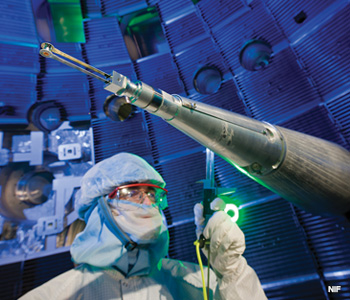 A positioner precisely centers the target inside the target chamber.
A positioner precisely centers the target inside the target chamber.
In February 2014, scientists at the U.S. National Ignition Facility (NIF)—the vast installation at Lawrence Livermore National Laboratory (LLNL), Calif., U.S.A., that has set its sights on laser-driven fusion—achieved a significant milestone: a fusion reaction that produced more energy than went into triggering it. The report came almost exactly five years after the facility first simultaneously fired its 192 high-power lasers at an empty target chamber. And it constituted some welcome good news for the NIF, which, after an optimistic start, had run into a variety of technical problems in its campaign for a fusion demonstration.
The NIF team achieved this milestone by rethinking its approach to generating the fusion-creating implosion, and in particular by reshaping the laser pulse shape to reduce instabilities that had vexed the project. But while a net-energy-positive reaction is an important technical achievement, the facility’s core goal of ignition—a self-sustaining fusion reaction—still appears to be many years off. Here’s a look at laser fusion’s road thus far at NIF, and what the future might hold.
The concept: creating a star on Earth
Since the discovery that thermonuclear fusion powers the sun, scientists have dreamed of harnessing fusion energy. But what the sun’s massive gravity can do with ease—fuse hydrogen nuclei together to form helium nuclei, releasing enormous energy, and contain the process to allow for a self-sustaining burn—has proved extremely hard to achieve on Earth with any great intensity or consistency over the past six decades. Much research has focused in particular on using magnetic fields to contain the fusion reaction, an approach still being pursued today.
With the invention and advance of laser technology, however, another possible method for achieving fusion came to light. Inertial confinement fusion involves the heating of frozen micrograms of deuterium and tritium, generally with high-power lasers, to drive the fusion reaction that would lead to ignition. In 1972, John Nuckolls and colleagues at LLNL proposed such a system, and sketched out the requirements in laser power, pulse shape, spherical symmetry and other key variables.
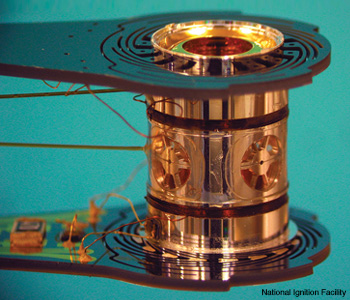 A gold cylinder called a hohlraum, about the size of a pencil eraser, holds the peppercorn-sized capsule of fusion fuel.
A gold cylinder called a hohlraum, about the size of a pencil eraser, holds the peppercorn-sized capsule of fusion fuel.
Ten years later, Nuckolls and colleagues fleshed out the concept further, suggesting the use of a “hohlraum” (German for “hollow area”) to contain the spherical fuel sample. Under this concept, lasers bombarding the hohlraum would be converted into X-rays in its interior cavity; those X-rays, in turn, would ablate the target and spur the implosion. It is this basic framework—the so-called indirect-drive method—that has underlain the NIF’s efforts to achieve ignition.
How it’s supposed to work
To create on Earth, even for an instant, the 100 million degree temperature and 100 billion atmosphere pressure conditions that exist only in the cores of stars and planets, the massive NIF begins with a 9.425-mm-long, 5.75-mm-diameter cylindrical gold cavity, the hohlraum. Inside the cavity is a 2 mm spherical pellet containing a frozen deuterium-tritium (D-T) mix surrounding cooled D-T gas, in a silicon-doped plastic coating. The hohlraum target—about the size of a pencil’s eraser—sits within a spherical target chamber 10 meters in diameter, which in turn is positioned inside NIF’s “Grand Central Station,” a concrete silo target bay 30 meters high and 30 meters in diameter.
The process of bombarding the hohlraum with laser energy begins with a weak laser pulse (approximately 1 nJ) that is ultimately boosted, through the NIF’s series of Nd-doped glass preamps and amplifiers, to a total energy of 1.9 MJ. That energy is delivered to the hohlraum through 192 separate main laser amplifier beamlines (in two parallel laser bays, each containing 96 beamlines). Within each beamline, adaptive optics (deformable mirrors that compensate for wavefront errors) and other devices improve the beam’s quality, control its characteristics, convert the pulses from infrared to ultraviolet, and focus them onto the pea-sized hohlraum. From inception to target chamber, the beams travel approximately 1,500 meters—in about 5 μs—and hit the target with a precision of better than 50 μm.
When the concentrated beams simultaneously hit the gold hohlraum, they create X-rays within the cavity that blast off the fuel pellet’s silicon-doped plastic coating. The remainder of the pellet is driven inwards in an implosion, compressing the fuel inside the capsule and creating a shock wave that adds more heat to the fuel and creates a “burn.” Although the laser is on for about 20 ns, most of the nuclear reactions take place in a “bang time” of only 100 to 200 ps.
If the implosion occurs symmetrically, and at a sufficient velocity (nearly 700,000 miles per hour), the deuterium and tritium atoms should be forced together in a fusion reaction lasting about 10 trillionths of a second and reaching a temperature hotter than the center of the sun. The fusion reaction produces alpha particles (helium nuclei) and neutrons. The alpha particles should add their energy to the D-T fuel, in turn heating it and increasing the rate of fusion reactions, producing more alpha particles in what is known as the “hotspot.”
This “bootstrapping” process is how the DT fusion burn rate will accelerate to eventually be self-sustaining—a propagating burn, or ignition. The ultimate goal is that the lab-generated star will produce 10 to 100 times more energy (neutron yield) than was used to ignite it.
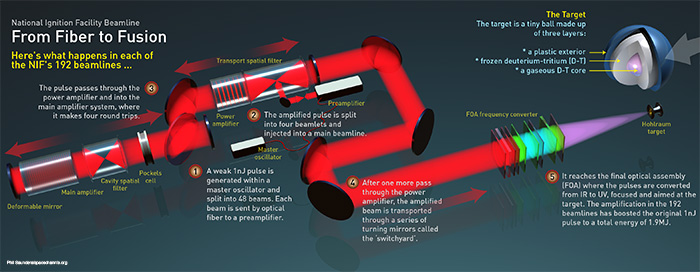 |
Troubled start
NIF first fired its 192 lasers in sync into the target chamber on 26 February 2009, and initial cryogenic implosions took place in September 2010. That marked the first of 37 such experiments conducted by the end of 2012, under the National Ignition Campaign (NIC), a drive that began in 2006 to achieve ignition at the facility by the end of September 2012. In addition to LLNL, NIC participants included Sandia National Lab, the Laboratory for Laser Energetics at the University of Rochester, MIT, and Lawrence Berkeley National Lab in the United States, the Atomic Weapons Establishment in the U.K., and the Commission on Atomic Energy in France.
|
The initial spirit at the facility—based on computer models and simulations of what would happen—was optimistic, with scientists even looking beyond the goal of ignition and toward prototypes for a laser fusion reactor.
But although the lasers at the NIF have performed extremely well, the creation of alpha particles and the neutron gain predicted by the modeling has proved difficult to achieve in practice, and has bogged down in a variety of details largely related to the behavior of the sample once the laser light interacts with plasma ions and electrons emitted from the gold hohlraum and helium ions inside it.
Inertial confinement fusion involves heating the target so that its nuclear fuel compresses to incredible densities, under pressures on the order of 350 Gbar. But the pressure needs to remain even all around the target, with no “3-D effects,” such as bulges or ridges, from an uneven pressure distribution. Richard Petrasso, senior scientist and division head of High-Energy-Density Physics at the Plasma Science and Fusion Center at MIT, likened it to trying to compress two handfuls of Jello “and reduce the radius by a factor of 30 without any of [it] squeezing out between your fingers.”
Scientists have also had to deal with complexities in laser-plasma interactions within the hohlraum. When the 1.9 MJ of laser energy hits the hohlraum, about 70 percent is converted to X-rays, just under 10 percent is absorbed by the capsule, and less than 1 percent actually gets into the fuel. The rest is lost through the generation of low-density plasma, laser-plasma interactions such as stimulated Brillouin scattering and stimulated Raman scattering, and X-rays that leak out through the laser entrance hole.
Another, critical problem was that the “ablator material”—the plastic shell on the pellet, the explosion of which drives the implosion of the hydrogen fuel—was apparently mixing into and contaminating the deuterium-tritium hotspot.
The result of these and other issues: By the September 2012 deadline of the NIC, the neutron yield was three to 10 times less than required to initiate alpha heating and a propagating burn, and the fuel was compressing to only half the pressure that predictions at the time said were required for ignition. It was time to step back and think about a different approach.
From “low foot” to “high foot”
After years of low neutron generation that didn’t reflect what simulations said would happen, the physicists suspected that ablation-front-driven instability was responsible. Also, the implosions weren’t occurring symmetrically, and the target itself contained imperfections. These and other issues had limited the compression of the target. An LLNL team, led by Omar Hurricane, started looking at solving the problem not by changing the sample characteristics, but by reshaping the laser pulse that kicked everything off.
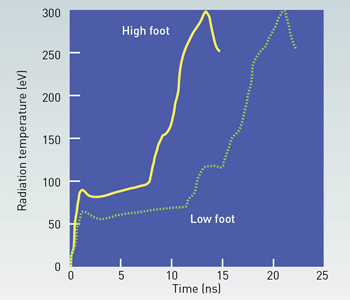
A quicker kickoff : By changing the pulse shape and width to deliver more energy earlier, the NIF team was able to reduce hydrodynamic instabilities in the sample. ©APS/Illustration by Joan Tycko, based on H.-S. Park, Phys. Rev. Lett. 112, 055001 (2014).
During the unsuccessful NIC, the facility had used a “low-foot” approach where the lasers first hit the target with relatively low power, driving a relatively low initial radiation temperature in the hohlraum during the front-end, or foot, of the pulse. The power is ramped up across the pulse and culminates in four shocks that ablate the outer shell and drive the fuel inward in an implosion.
The team led by Hurricane developed a new approach called the “high-foot” method, a laser pulse shape modification designed to reduce hydrodynamic instability by hitting the target with a harder blast initially. “The laser power was essentially doubled early in time, which has the net effect of making the implosion less hydrodynamically unstable, at the cost of making the implosion less compressible,” Hurricane said. “Also, the new laser pulse-shape launches three shocks into the implosion versus four shocks, which also helps with hydrodynamic stability. Finally, the overall pulse-length is shorter in time”—approximately 15 ns, versus 22 ns in earlier experiments.
Using the high-foot method, the team reported this past February that for the first time, the energy coming out of the plasma exceeded the amount of energy that was deposited into the deuterium-tritium fusion fuel. That’s a long way from the NIC’s target of ignition by 2012, but an important milestone nonetheless.
“This approach that Omar and people have taken is to step back and say, hey look, let’s try and do something a little less ambitious,” said Petrasso, whose lab makes some of the diagnostics used at the NIF to evaluate the implosions and who has worked in inertial confinement fusion for 25 years. “And by doing that, what they’re doing is they’re making the whole implosion process more 1-D in character.”
Although the net energy reported from the recent experiments is tiny—“about 27 kilojoules is our best so far,” Hurricane said—it represents an order of magnitude increase in energy output, and is encouraging, scientists say. More encouraging still, the high-foot method is also demonstrating record neutron yield and alpha particle creation. In the recent shots, within the last six to eight months, “basically half of the neutrons that are coming out of these implosions are being generated by alpha heating,” Petrasso said.
“Before the first definitive tests, a lot of time, mental energy and emotional energy by the team was required, so it was quite gratifying to see things start to work at first, then make some substantial gains,” Hurricane said. “Still, every experiment is a nail-biter, and the team performs valiantly to make every shot work.”
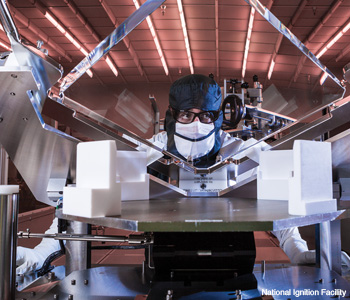 Optics processing of Target Wedged Focus Lens into cleaning/coating frame.
Optics processing of Target Wedged Focus Lens into cleaning/coating frame.
Next steps at NIF
In the wake of the initial success of the high-foot method, the coming year will be a busy period at the NIF. In its 2012 post-mortem report to Congress on the shortfalls of the NIC and the road ahead, NNSA proposed a three-year program to better understand the physics of ignition, at which point it will decide whether, and how, ignition can be achieved. The deadline for that decision is October 2015.
Since publication of the February report, researchers at NIF have conducted a series of “mini campaigns” under a new scheduling paradigm designed, among other things, to reduce the time between target shots. The team is also exploring new strategies for the hohlraum. “At present,” the team wrote in February, “hohlraum physics is limiting our ability to use the full power capability on the NIF while maintaining an acceptable hotspot shape.”
“From a technical point of view, the challenge is basically one of precise finessed control,” said Hurricane. “We need better control of our implosion shape in-flight and we need to finesse the pulse-shape more in order to retain the stability benefits that we have with our new implosion, but avoid putting too much entropy into the D-T fuel like we have presently.”
But the project is still a long way from achieving ignition. “The biggest limitation right now is laser energy,” Hurricane said. To work around needing more, “we are trying to further finesse the pulse shape in a way that gives us the better implosion control that we have presently, but also allows for more compression in the implosion. More compression of the fusion fuel lowers the ignition energy requirement.”
“While I think this approach is very important for us to see how far we can go on it, it may not lead to the promised ignition land,” Petrasso said. “But it’s getting us obviously a whole lot closer.”
Long road to fusion energy
If the indirect-drive approach at NIF ultimately fails, several other methods could be pursued before researchers would have to throw in the towel. An alternative called polar direct drive (PDD) has shown promise at the Omega laser at the Laboratory for Laser Energetics at the University of Rochester, U.S.A. PDD could conceivably be implemented at NIF with some modifications to the optical beamlines, and is being tested at Omega using 40 of its 60 beams. Magnetically driven implosions (pulsed power drive) represent another option, being pursued at the refurbished Z-machine at Sandia.
There are also voices that question the wisdom of fusion studies in general, and whether the investment could be better spent elsewhere. Christopher Paine, the director of nuclear programs at the Natural Resources Defense Council, told Bloomberg Markets last year: “If we’d spent the same $6 billion to study energy storage, we’d have a massive deployment of solar technology.”
Journalist, author and longtime fusion skeptic Charles Seife—author of the book Sun in a Bottle: The Strange History of Fusion and the Science of Wishful Thinking—believes that the most recent announcements from NIF merely shown that the program has “redefined [its] definition of success.” Seife sees fundamental problems in the inefficiencies of lasers to drive fusion. “We’re a factor of 100-plus away from producing energy,” he says. “Laser fusion is not even a twinkle in someone’s eye at this point.”
At NIF, Hurricane acknowledges that even if the current work at NIF illuminates a clear path to ignition, the road from there to workable fusion power would be a long one. “To get to the regime of being practically useful, the fusing region needs to ignite in the center of the implosion, then propagate into the surrounding cold fusion fuel to get substantially more energy out,” he says. “Even when ignition and propagation occur, the energy gain will need to be high enough to offset the laser energy cost. And then engineering solutions would be required to do many shots repeatedly,” he adds.
“This is a scientific endeavor at this point to see what it takes to get this to work, and it will be a long time before it’s practical,” Hurricane says. “It’s anyone’s guess how long, but years is unrealistically short.”
Nonetheless, the laser fusion community has been generally encouraged by the recent results from the NIF.
“Personally, I am optimistic that we will achieve ignition,” Petrasso said. “We didn’t achieve it when the first estimates were made. We were probably, I think, unduly optimistic before we started factually looking at things and saying, What are some of the real problems? I think now we’re in a much better position to see what the problems are, and approaches to dealing with them.”
Melinda Rose is a freelance writer specializing in optics and photonics.
References and Resources
-
J. Nuckolls et al. “Laser compression of matter to super-high densities: Thermonuclear (CTR) applications,” Nature 239, 139 (1972).
-
J.H. Nuckolls. “Feasibility of inertial-confinement fusion,” Physics Today 35(9), 24 (1982).
-
O.A. Hurricane et al. “Fuel gain exceeding unity in an inertially confined fusion explosion,” Nature 506, 343 (2014).

